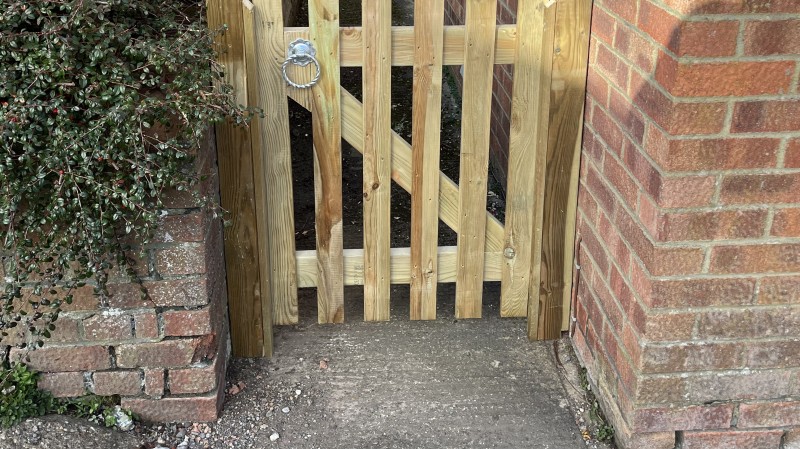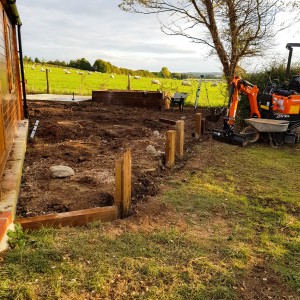You are here: Choosing a Garden Gate
Whilst a garden gate of course helps control access to your property, it is not entirely utilitarian. Chosen carefully, a garden gate can frame the approach your home beautifully, and fit well within any boundary wall, fence or hedge.
When choosing a garden gate, there will be a range of factors to consider, some practical and some aesthetic. To a greater or lesser extent, you will be constrained by the space available and layout of your garden. You may also feel bound by tradition: obligated to stick to the likes of an existing or original garden gate (in terms of height, design, material etc.), without considering a change of form.

Many of the practical considerations will be made instinctively based on what purposes you want your gate to serve. For example, you may intuit whether it should open inwards or outwards; the level of security you need in terms of its weight, latches, bolts, or locks; how high it should be to safely contain pets or small children; whether it should be a solid design to maintain privacy. Similarly, you may have a concrete idea of what material would best complement the surroundings, based on neighbouring properties.
Whilst bearing in mind these constraints and your intuition, it is worth carefully considering the options available. After all, a garden gate will become an integral part of your property and it will need to fit and function well. The following is a homeowners’ guide to choosing a garden gate, outlining the key considerations.
Why install a garden gate?
Depending on the layout of your property and garden, the garden gate could well be the first thing visitors notice when they approach. A well-chosen gate can therefore help style the exterior and enhance the property itself.
Furthermore, any barrier to your property acts as a deterrent to would-be intruders. Tall, heavy garden gates, ideally fitted with a bolt or padlock, undoubtedly offer the greatest security from intruders. Some designs (such as solid wood or composite gates) also act as a visual barrier, preventing anyone seeing into your garden/property and what you may have of value within. However, even small gates act as a barrier to would-be intruders: if approaching in the dark, clambering over even a 0.9m gate could create unwanted noise and raise the alarm.
Homeowners with pets or small children will benefit from a barrier between the safety of their property and the world outside. Whilst fencing or garden walls form a more solid, secure boundary, a garden gate offers the best of both worlds: allowing access (for example visitors, post, deliveries) whilst also forming a reliable barrier.
There are also some drawbacks to garden gates. They can be a potential weak point in an otherwise strong boundary, and they will only offer security and ease of access if they are well maintained. Like garden walls, gates will be exposed to the vagaries of Great British weather, and as such will age and suffer general wear and tear over time.
This then leads us to the long-term view: you will need to put some time, energy and money into maintaining the gate over its lifetime or over the course of your homeownership. This ensures the gate is kept in good working order and looking its best, too. The type and extent of maintenance required will depend on what material the gate is made of (see below).
Material
When choosing your garden gate, arguably the major factors to consider are:
- Is it affordable?
- What do I need in terms of height and design?
- Will it complement the property and garden?
- What ongoing maintenance is required? What are the costs (time and materials) associated with this?
Many of these are determined by which material your gate is made of, so choosing the material is a good place to start. The two most common types of material used for garden gates are woods and metals, but composite gates are becoming increasingly popular.
The cost of each gate will vary according to size, material and what installation is required (for example, if you are installing yourself or having professional installation, whether the posts need to be set in concrete etc., whether the size required is standard or would need a bespoke gate to be made). What is more, due to the unpredictable pricing of materials involved, many suppliers are currently not including pricing in their online or printed product catalogues. There are so many variables to factor in, it is unhelpful to attempt a ‘ballpark’ idea of cost for each type of gate. As a rule of thumb, wood and metal gates are cheaper than composite gates, with softwoods being cheaper than hardwoods.
Wood
Wood lends itself to blending into a garden beyond; this is especially true of countryside homes. In terms of ongoing maintenance, generally a wooden garden gate will need oiling once or twice a year. Oiling helps protect the wood from temperature- and moisture-related changes, prevents insect and fungal attack, and can provide UV protection and can add some colour too (if combined with a wood stain). Microporous wood oils and stains are available which allow the wood to ‘breathe’.
Wood oils with stains are generally available from around £20-25 per litre. Like wood oils, wood stains provide colour by penetrating the timber itself; depending on brand, colour and features, stains are generally available from around £11-£20 for 750ml. You can add an additional layer of protection by applying a varnish or paint to your wooden gate, after staining; it will need re-varnishing ideally every 1-2 years, but at least every 2-3 years. You can expect to pay around £10-15 for 750ml of varnish.
However well maintained your wooden gate is, it is a natural material that is exposed to the elements; it will react to changes in its environment including temperature, moisture and UV exposure, and will be susceptible to insect damage. As such, over time wooden gates will be prone to rotting, fading, warping, bending, splitting or cracking. Periodic inspection is required to identify signs of damage and carry out repair works in a timely manner.
Hardwood
Hardwoods, such as Oak, are generally more expensive than softwoods on account of the fact that they take longer to grow and are often sourced outside of Europe. Common hardwoods used in garden gates include Oak and Iroko. The key benefit of hardwoods is that they are heavier and more durable than softwoods. Despite their hardiness, they will still need to be oiled regularly (ideally twice a year). A well-maintained hardwood gate usually has a lifespan upwards of 30 years.
Softwood
Softwoods are generally cheaper, as there is a plentiful supply within Europe and these trees (such as Redwood, Scots pine, spruce etc.) grow relatively quickly. Timber for softwood garden gates will need to be treated with a preservative to help it withstand weathering; often, softwoods are pressure treated to this end.
Typically, a well-maintained softwood gate can last upwards of 15 years. Although softwoods are considered a more sustainable option than hardwoods, they will need to be replaced more often. In either case, look for certification from the Forest Stewardship Council (FSC) to ensure the wood has been sustainably sourced.
Metal
More modern homes, those in urban/suburban settings or with a brick boundary wall, might benefit from metal gates. These are commonly made from wrought iron, steel or aluminium, with iron usually being one of the most expensive options, and aluminium the most light weight. Metal gates should be galvanised or zinc-plated to help protect from corrosion. Metal paints can also be used to style your gate, and often the gates are sold with powder paint coating. The lifespan you can expect will vary according to the metal and manufacturer, but if well-maintained they can serve your home for decades.
Metal gates require slightly less time-consuming maintenance than their wooden alternatives. A biannual wash with warm soapy water will remove surface dirt, and a small brush can be used to reach trickier areas around hinges or latches; the gate can be allowed to air-dry and finished with a coat of metal wax if preferred.
Periodic inspection for patches of rust (in the case of iron or steel) or other corrosion (aluminium oxide, in the case of aluminium) is important. Small areas of corrosion or rust can usually be removed with steel wool (around £1-£3), chemical rust-removers (around £8-£10 for 500ml), metal brushes (a set of two or more will set you back around £5-£10) or high-grit sandpaper (a pack of 6 sheets costs around £5). Also look out for other signs of damage such as bent metalwork, missing parts on hinges/latches; these will need to be repaired.
If painted, the metal gates will need touch ups and repainting as required. Be sure to first use a primer suitable for metal (with a rust inhibitor if possible). A metal primer with rust inhibitor will cost around £20-£25 per litre for a reputable brand; metal paints can cost anywhere between £13-40 per litre, depending on brand and colour.
Composite
Composite gates can suit a range of properties and gardens. Composite gates often sit within an aluminium frame, and consist of composite slabs fitted around an infill, or steel frame. The composite slabs are made from recycled materials such as glass, powdered wood and bamboo, thermoplastics and plastics, which make them an eco-friendly alternative to those who would otherwise choose wood. They can also come in a wood-effect finish for those who want the best of both worlds.
Composite is largely weatherproof, so it won’t warp, rust or rot. What is more, composite gates require no ongoing maintenance in terms of staining, oiling or waxing, and have an impressive lifespan (upwards of 50 years). The metal frame will require periodic inspection for signs of damage.
The downside of composite gates largely falls to their cost. They are more expensive than wooden gates, but the larger up-front cost is then offset by their lifespan and very low maintenance costs. In terms of security, composite gates are somewhat limiting in that attaching bolts or other external locks to their surface isn’t possible; most composite garden gates will therefore include a built-in lock or latch. Lastly, although composite gates are often made with materials that resist fading over time, they will inevitably fade with their initial exposure to UV (within the first few months after installation).
Installation
Those confident with DIY may be able to tackle installing gate posts and hanging their gate with relative ease. Several big-name DIY store sell standard-sized garden gates and posts. For some, it is well worth having professional installation that ensures the gate is hung properly and is therefore safe and secure.
If you are tackling this yourself, measuring up carefully beforehand it key. There are many online guides for measuring, and undoubtedly your chosen supplier will have a comprehensive guide available to use when measuring up for their products. Remember to factor in the space you will need for gate posts or wall plates, the width of the actual gate itself, as well as enough clearance (usually 10mm) between the gate and each post.
Planning
If you are replacing an existing garden gate or installing a new one, the Planning Portal advises that you won’t need planning permission provided the new gate is not higher than:
- the existing gate (if applicable)
- 1m, if next to a highway or footpath bordering highway
- 2m if anywhere else.
Exceptions to this would be if you live in a Conservation Area, if the gate is within the grounds of a Listed Building, or if there is a restrictive covenant or Article 4 Direction in place which affects the property. In these circumstances, it would be wise to contact your Local Authority planning department for guidance on what permissions will be required.
Summary
There are both aesthetic and practical considerations to be made when choosing a garden gate. In practical terms, the garden gate might see the household through their daily comings and goings, as well as visitors, deliveries and so on; you will need to think about height, design, ease of access and security amongst other things, to make sure the gate does what you need it to do. In terms of visual impact, you will need to decide which material works best with your property and budget. Whichever material you choose, consider the maintenance and repair requirements, lifespan, and sustainability. Lastly, make sure your new gate adheres to any planning restrictions and check with your Local Authority if necessary.
If you are looking to make some home improvements, you may find some of these services useful
Garden Design
If you are considering improving your garden
Japanese Knotweed
Is Japanese Knotweed really as bad as you think?
Building Regulations
Find details of local experts who can help with Building Regulations
Builders
Find local help with a building project
Architectural Design Services
Find local Architectural Design experts
Structural Inspections
Find an expert to carry out a structural inspection
Choose which Architectural service you require
If you are not sure which service you require, check out the options available...



